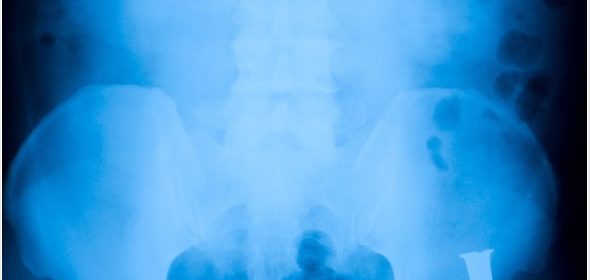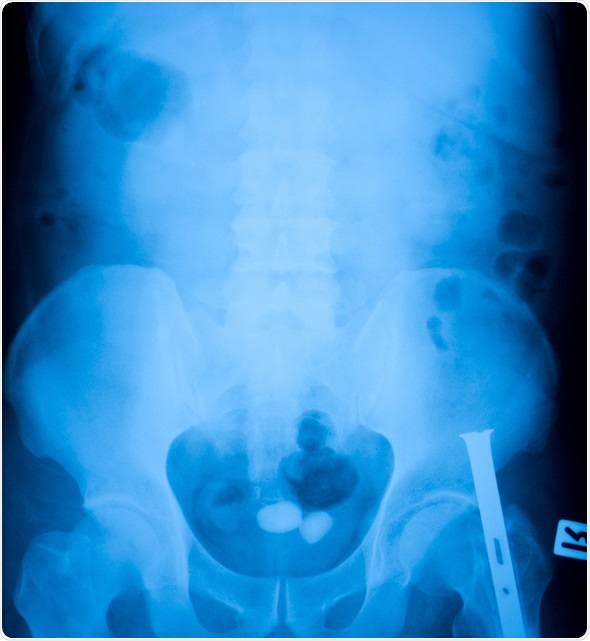Symptoms and Diagnosis of Bladder Stones

Bladder stones are hard masses of mineral that form in the bladder when it doesn’t empty entirely. Some patients with bladder stones may not notice any symptoms, as the lumps are small enough to pass out of the bladder and be excreted in the urine. However, other patients with larger stones that irritate the bladder wall or obstruct the urine flow report several symptoms.
Diagnosis of bladder stones involves a consultation to discuss medical history and a physical examination. This is often followed by diagnostic imaging techniques, such as a spiral computed tomography (CT) scan, x-ray or ultrasound to confirm the presence of bladder stones.

Symptoms
Symptoms of bladder stones are usually only evident when the stones irritate the bladder lining or obstruct the flow of urine. The typical symptoms of a patient presenting with bladder stones may include:
- Moderate-severe lower abdominal pain
- Difficulty or pain upon urination
- Frequent urge to urinate
- Cloudy or dark urine
- Hematuria
- Pain in or around penis (in men)
It is common for the flow of urine to suddenly stop and the patient to experience some pain in the penis, scrotum, perineum back or hip. Additionally, many patients with bladder stones also have a urinary tract infection (UTI), with symptoms such as pain and fever. This is because a UTI can both cause and result from bladder stones.
Initial Diagnostic Tests
The diagnosis of bladder stones usually begins with a comprehensive medical history, including past procedures in the pelvic region.
A physical exam is the next step to investigate the cause of the symptoms, specifically enlargement of the bladder in the lower abdominal region. A rectal examination is also usually needed for men that present with symptoms, as it can reveal an enlarged prostate or related problems.
A urine culture is often collected for urinalysis, to examine for the presence of blood, bacteria and or crystallized mineral in the urine. This is also useful to detect a urinary tract infection.
In some cases, cystoscopy may also be indicated to further investigate the cause of the symptoms and make an accurate diagnosis.
Diagnostic Imaging Techniques
The most common imaging technique to diagnose bladder stone is computerized tomography (CT) scan, which creates cross-sectional images of the abdominal region to detect bladder stones. A spiral CT scan is more efficient and provides greater definition of the internal structures that can detect even small stones and provides results more quickly.
An intravenous pyelogram is a special type of imaging test that involves the injection of a contrast material into a vein that is excreted via the renal tract. X-ray imaging is then used at regular intervals throughout this process to observe the movement of the material and check for bladder stones.
Ultrasound uses the reflection of sound waves off the organs and internal structures to visualize the bladder and detect any stones present.
X-ray imaging can be sometimes used to detect the presence of bladder stones in the urinary system, however, this test is less sensitive and does not show all stones.
It is important for patients with bladder stones to be diagnosed as soon as possible to allow them to receive adequate treatment for the condition and minimise any complications that may occur.
References
- http://www.nhs.uk/conditions/bladder-stones/pages/introduction.aspx
- http://www.nytimes.com/health/guides/disease/bladder-stones/overview.html#Symptoms
- http://emedicine.medscape.com/article/2120102-clinical
- http://www.mayoclinic.org/diseases-conditions/bladder-stones/basics/tests-diagnosis/con-20030296
Further Reading
- All Bladder Stones Content
- Prevention and Management of Bladder Stones
- What Are Cystoscopy and Ureteroscopy?
Last Updated: Aug 23, 2018

Written by
Yolanda Smith
Yolanda graduated with a Bachelor of Pharmacy at the University of South Australia and has experience working in both Australia and Italy. She is passionate about how medicine, diet and lifestyle affect our health and enjoys helping people understand this. In her spare time she loves to explore the world and learn about new cultures and languages.
Source: Read Full Article